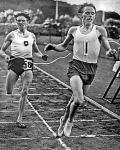A tribute to the career of Gunder Hägg

Swedish running legend set the Mile world record three times and with countryman Arne Andersson, the duo approached the "magic" sub-4 minute mark
By Lennart Julin for the IAAF
Renowned Swedish Athletics historian and statistican Lennart Julin gives his own personal tribute to the life and career of Gunder Hägg, who set the Mile world record three times in the early 1940s.
Usually it takes a number of Olympic gold medals to achieve the status as a true legend of our sport but Swedish runner Gunder Hägg - who on Saturday passed away at the age of 85 - belonged to a very select group of extraordinary athletes who have managed to become icons despite lack of Olympic success.
The athletic career of Gunder Hägg was such that had he been born in the USA it would – without the need for any additions to the bare facts – certainly have been used as script for a sentimental Hollywood film because the story contained just about every element of drama, emotion, success and failure needed.
It all began on New Year’s Eve 1918 when Gunder Hägg was born on a small farm in the forests of northern Sweden. From a fairly early age he had to help out on the family farm where the main income came from timber work. His school was three kilometers away a distance which he walked, ran or traveled by ski (in the winter) every day.
Kälarne’s inspiration
However, serious competitive sports was not really something he considered until he and his father started to hear about the running success of a six-years-older boy from a nearby village. That boy Henry Jonsson (later Henry Kälarne) thanks to his athletic ability had not only become famous but also - and more importantly - got a good job in the fire brigade in “the big city”.
This kindled thoughts of “If Henry – why not also me?” and one summer day in 1936 Hägg’s father measured a 750 meter course on a trail in the woods and asked him to run this course back and forth, while he (the father) would time the run on the alarm clock, and when he came back his father reported his time was 4:45.
That was the decisive moment and Hägg started to compete in local meets and ended the year with personal best of 4:14 and 16:11. Times which are still quite respectable for a 17-years-old beginner.
Already the following year the whole nation became fully aware of this exceptional talent from the province of Jämtland: He was invited to compete for the first time in the Stockholm Olympic Stadium and finished 4th in 8:36.8 in an international 3000m race. At age 18!
The following year he got his first national championships medal when finishing 2nd in the steeplechase (!) and his plans for 1939 were ambitious. However, a serious case of pneumonia disrupted all plans and when he left the hospital he was told by the doctor that he had better give up all plans of returning to competitive sport.
But Hägg did not listen to that advice, instead while doing his military service in northernmost Sweden during a very cold winter he started training intensely more or less every day by running in deep snow. And when the summer came he suddenly found he had arrived in the world elite.
Two races - although he lost both to Henry Kälarne - stood out: On August 4, Hägg finished just a fraction behind Kälarne’s 1500m national record equalling 3:48.8 and on 14 August he ran 8:11.8 for 3000m which was three seconds faster than the previous world record but only good for 2nd in the race.
The magic summer of 1942
Gunder Hägg’s first world record of his own came in 1941 when he won the Swedish 1500m title in 3:47.6 lowering Jack Lovelock’s winning time from the 1936 Olympics by two tenths. But it was 1942 that would become Hägg’s “Year of Years”. In late summer of 1941 he was suspended for a minor infringement of the amateur rules, and he was not allowed to compete until July 1, 1942.
Perhaps this was a blessing in disguise as he was able to bulk up on both mental and physical energy and he certainly returned “with a bang”: In a Mile race in Göteborg he won a hard fought battle with countryman and fellow legend Arne Andersson in the world record of 4:06.2. This signaled the beginning of a truly amazing period of 12 weeks that produce 10 world records by Gunder the Wonder!
July 1: 4:06.2 (1 Mile)
July 3: 8:47.8 (2 Miles)
July 17: 3:45.8 (1500m)
July 21: 5:16.4 (2000m)
August 23: 5:11.8 (2000m)
August 28: 8:01.2 (3000m)
September 4: 4:04.6 (1 Mile)
September 11: 13:35.4 (3 Miles)
September 20: 13:32.4 (3 Miles) and 13:58.2 (5000m)
Continue reading at: iaaf.org
